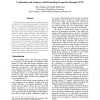Free Online Productivity Tools
i2Speak
i2Symbol
i2OCR
iTex2Img
iWeb2Print
iWeb2Shot
i2Type
iPdf2Split
iPdf2Merge
i2Bopomofo
i2Arabic
i2Style
i2Image
i2PDF
iLatex2Rtf
Sci2ools
116
Voted
IOLTS
2008
IEEE
2008
IEEE
Verification and Analysis of Self-Checking Properties through ATPG
Present and future semiconductor technologies are characterized by increasing parameters variations as well as an increasing susceptibility to external disturbances. Transient errors during system operation are no longer restricted to memories but also affect random logic, and a robust design becomes mandatory to ensure a reliable system operation. Self-checking circuits rely on redundancy to detect and compensate errors online. However, during synthesis and optimization self-checking properties can be destroyed. This paper shows how automatic test pattern generation (ATPG) can be used to analyze self-checking properties. As a result the properties are either verified or the fault detection profile provided by ATPG can be used to increase the error detection or fault tolerance capabilities of the design. Experimental data are shown for several self-checking arithmetic circuits.
IOLTS 2008 | Optimization Self-checking Properties | Self-checking Circuits | Self-checking Properties | Software Engineering |
Related Content
| Added | 31 May 2010 |
| Updated | 31 May 2010 |
| Type | Conference |
| Year | 2008 |
| Where | IOLTS |
| Authors | Marc Hunger, Sybille Hellebrand |
Comments (0)

